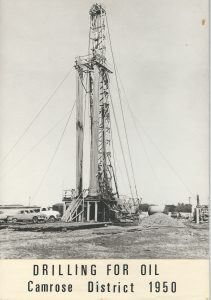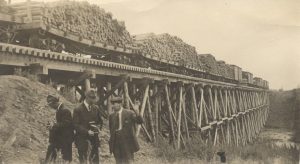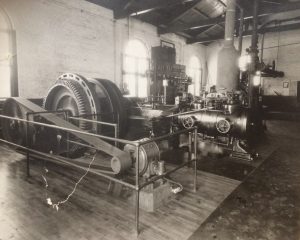The “Natural” World
What I love about nature and what I love about machines is resiliency…

A derrick, operating in 1950, shows the long history of Camrose and Industry
Easily one of the hardest things to reconcile with nature writing is Industry. Smokestacks spewing acrid smoke, industrial runoff destroying thousands of miles of river ecosystems, and lithium ponds all seemed poised like merciless combatants in a bloody war against nature. It’s been a trope that’s existed for hundreds of years and still plays out in a million ways today.
It is impossible to deny the impact of industries on Camrose and Mirror Lake. The lake wasn’t built for aesthetics, or to help with stormwater capture, or to provide a wetlands ecosystem for those species devastated by agricultural practices. It was built for Industry. Steam engines, power plants, electricity, utilities. The creation of the lake is almost antithetical to nature, and I think we would be remiss to deny that. Even Camrose itself has been built and grown with Industry. First, it bloomed because of the railway, colonialism, and agriculture. Now, it is sustained by pipe plants and crush plants. Extraction economies.

Constructed from thousands of logs, the Grand Trunk Trestle Bridge shows how much Industry needs nature
Any aerial picture, or even a short drive around town in the summer, and it’s hard not to notice how green and beautiful the town is now. Wilderness and parks are everywhere, all connected in a complex maze of walking trails that innervate the entire town. Then, in the heart of Camrose, sits the jewel of Mirror Lake. Yet, beneath its shimmering surface is a dark past, and even now it’s hard to not think about how much of the town is financially maintained directly or indirectly by extraction economies. Are we robbing Peter to pay Paul?
Maybe.
I am a proud member of possibly the last generation of Canadians who spent most of their childhood outside. After school until supper, after supper until bed (when I wasn’t grounded of course), I spent my days exploring some of the best topography Canada had to offer, from acreage life to a mountaintop forest. Alongside that, I have always carried a love of machines, especially engines, firearms, and industrial processing tools (like the awe-inspiring metal lathe). I love cedar trees about as much as I loved the scratch-built power saw we used to process logs at the mill my Opa owned.

The inside of the Camrose power plant shows some of the beauty of machines
With that said, I have learned at least something about how to reconcile the two forces, and it involves purchasing practices.
The most environmentally sustainable product is the product you didn’t buy. The second most sustainable is the product you only have to buy once. I think both nature and industry benefit from resilient engineering.
I don’t hate Industry. And I don’t love nature. I am somewhere in between, and maybe that’s where Mirror Lake is too. Nature, built and sustained by Industry. What a strange thought.
Sources cited on this page:
Camrose and District Centennial Museum, Accession 1989.9.29d, image (Trestle Bridge Over Stoney Creek).
Camrose and District Centennial Museum, Accession 2015.1.297, image (Drilling for Oil, Camrose, 1950).
Camrose and District Centennial Museum, Accession 2017.1.65, image (Inside Power Plant).